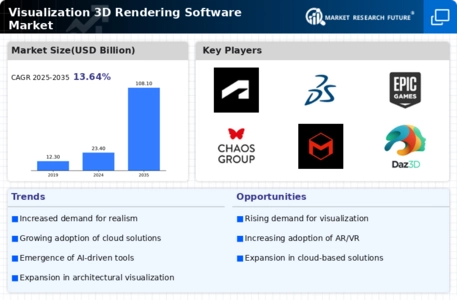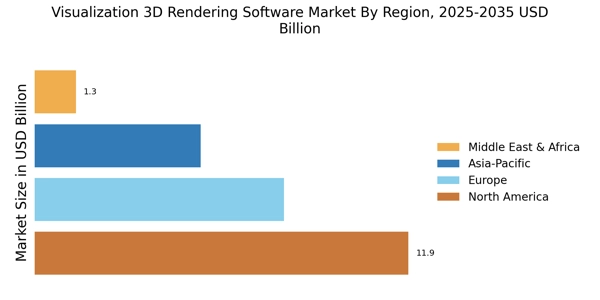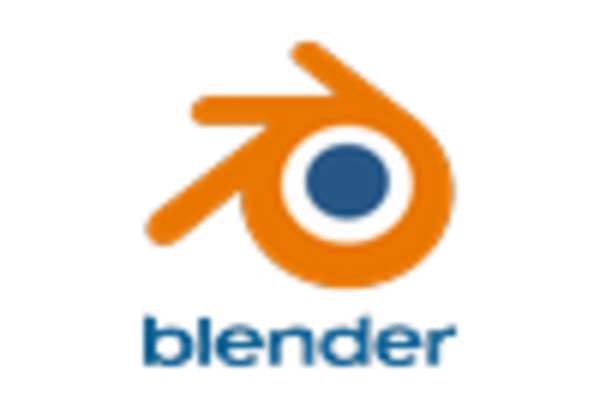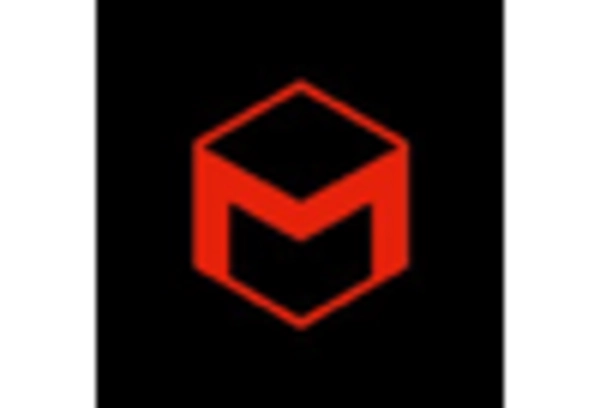Growth in Architectural Visualization
The Visualization 3D Rendering Software Market is witnessing substantial growth due to the rising demand for architectural visualization. Architects and real estate developers are increasingly leveraging 3D rendering software to create detailed visual representations of their projects. This trend is fueled by the need for effective communication with clients and stakeholders, as well as the desire to showcase designs in a compelling manner. Recent data indicates that the architectural visualization market is projected to grow at a compound annual growth rate (CAGR) of over 20% through 2026. As a result, the Visualization 3D Rendering Software Market is likely to benefit from this growth, as professionals seek advanced tools that enhance their design presentations and facilitate client approvals.
Increased Adoption of Virtual Reality
The Visualization 3D Rendering Software Market is experiencing a notable surge in the adoption of virtual reality (VR) technologies across various sectors. Industries such as gaming, architecture, and education are increasingly utilizing VR to create immersive experiences. This trend is driven by the growing demand for realistic simulations and interactive environments. According to recent data, the VR market is projected to reach a valuation of approximately 44 billion USD by 2024, which indicates a robust growth trajectory. As organizations seek to enhance user engagement and training effectiveness, the need for advanced 3D rendering software becomes paramount. Consequently, this driver is likely to propel the Visualization 3D Rendering Software Market forward, as companies invest in tools that facilitate the creation of high-quality VR content.
Expansion of the Entertainment Industry
The Visualization 3D Rendering Software Market is significantly influenced by the expansion of the entertainment sector, particularly in film and animation. The demand for high-quality visual effects and realistic animations has surged, prompting studios to invest in sophisticated rendering software. Recent statistics suggest that the global film industry is expected to surpass 50 billion USD by 2025, which underscores the increasing financial commitment to visual storytelling. As filmmakers and animators strive to push creative boundaries, the need for advanced 3D rendering solutions becomes critical. This expansion not only drives software sales but also encourages innovation within the Visualization 3D Rendering Software Market, as developers seek to meet the evolving needs of content creators.
Rising Demand for Interactive Marketing Solutions
The Visualization 3D Rendering Software Market is increasingly influenced by the rising demand for interactive marketing solutions. Businesses are recognizing the value of engaging customers through visually appealing and interactive content. This trend is particularly evident in sectors such as retail and real estate, where 3D visualizations can enhance product presentations and virtual tours. Recent market analysis indicates that interactive content can lead to a 70% increase in engagement rates compared to static content. As companies seek to differentiate themselves in a crowded marketplace, the need for advanced 3D rendering software that supports interactive features is likely to grow. This driver not only highlights the importance of visual communication but also underscores the evolving landscape of the Visualization 3D Rendering Software Market.
Technological Advancements in Rendering Techniques
The Visualization 3D Rendering Software Market is propelled by continuous technological advancements in rendering techniques. Innovations such as ray tracing, real-time rendering, and machine learning algorithms are transforming the capabilities of 3D rendering software. These advancements enable artists and designers to produce highly realistic images and animations with greater efficiency. As rendering technology evolves, the demand for software that incorporates these cutting-edge techniques is expected to rise. Market Research Future suggest that the integration of AI-driven rendering solutions could enhance productivity and reduce rendering times significantly. Consequently, this driver is likely to shape the future of the Visualization 3D Rendering Software Market, as companies strive to stay competitive by adopting the latest technologies.


















Leave a Comment